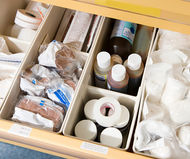April 4, 2025
5 Ways to Organize Your Medical Supplies for Easy Access
Keeping your medical supplies organized ensures they are readily available when needed, reducing stress and improving efficiency. Whether you're managing daily medications, first aid essentials, or specialized medical equipment, having a system in place can make all the difference. Here are five effective ways to organize your medical supplies for easy access.

1. Use Clear Storage Bins and Labels
Storing medical supplies in clear, labeled containers helps you quickly locate what you need. Use stackable bins or plastic drawers to separate different types of supplies, such as:
-
Bandages and wound care
-
Medications and prescriptions
-
Thermometers, blood pressure monitors, and other diagnostic tools
-
Personal protective equipment (PPE) like masks and gloves
Consider using a label maker or pre-made stickers to ensure each category is easy to identify. This organization method prevents clutter and ensures everything is in its designated place.

2. Designate a Centralized Storage Area
Designate a specific area in your home for first aid supplies. A cabinet, drawer, or shelf in the kitchen or bathroom can serve as a central location. Make sure it's easily accessible to all family members but kept out of reach of young children.
For an added level of convenience, consider keeping a smaller, portable first aid kit in your car, workplace, or travel bag. These kits should include essentials such as adhesive bandages, antiseptic wipes, and pain relievers.

3. Sort and Rotate Expired Medications
Regularly check expiration dates on medications and dispose of any that are outdated. Keeping expired medicine can be ineffective or even harmful. To maintain an up-to-date supply, follow these steps:
-
Schedule a monthly or quarterly check-up of your medical supplies.
-
Use a marker to label expiration dates on medicine bottles clearly.
-
Follow proper disposal methods for expired medications, such as pharmacy take-back programs or designated disposal bins.
-
Restock essentials before they run out, ensuring you always have what you need on hand.

4. Arrange by Frequency of Use
For items used daily, such as thermometers, blood pressure monitors, or diabetic testing kits, a wall-mounted organizer or hanging pockets can be a great solution. This setup keeps supplies visible and accessible while freeing up counter or drawer space.
You can use:
-
Hanging shoe organizers with clear pockets
-
Over-the-door storage racks
-
Magnetic strips for small metal instruments like tweezers and scissors
This method ensures that frequently used supplies are always within reach and not buried in cluttered drawers.

5. Create a Checklist and Emergency Plan
Having a written checklist of your medical supplies helps track inventory and prevents missing crucial items. Consider keeping a printed or digital list that includes:
-
Essential over-the-counter and prescription medications
-
Emergency contact numbers for doctors and poison control
-
Instructions for using medical devices such as inhalers or insulin pumps
-
Notes on allergies or specific medical conditions of family members
Additionally, create an emergency plan outlining where supplies are stored and how to use them in case of an urgent situation. Keep a copy in your emergency kit or a visible location like the refrigerator door.
A well-organized medical supply system not only improves efficiency but also enhances safety and preparedness. By implementing these five strategies, you can ensure that essential supplies are always within reach, making it easier to handle medical situations with confidence. Start organizing today for peace of mind and better health management!

